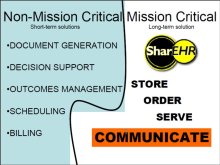SharEHR is a cloud-based EHR that uses your current records


Amazon cloud, turn it into a searchable PDF, then invite those who need access to see the record?
That deceptively-simple concept is called SharEHR (pronounced share), an Electronic Health Record (EHR) system launching today from United Medical Records, LLC (UMR), Cheltenham, Penn.
ZDNet Healthcare got an exclusive look at the new system and an interview with CEO Paul Eckert.
Eckert says his Randomized to Structured Data (R2SD) technology can turn any file loaded into SharEHR into a searchable PDF that can also be sorted and shared.
“Everyone has taken an ornate, complicated approach like HL7 when it's as simple as upload, convert to PDF, and then you can selectively share, lock down, collectively share and that's it,” he says.
Because SharEHR uses current files, including scanned paper, it takes a staff just a few weeks to learn how to use it, Eckert says.
Here's an example, which Eckert calls SharEHR Pass.
“Rather than sending a fax to a specialist you want to consult with a patient, and telling the patient to consult the specialist, why not pass a message to the specialist's assistant, with a link to the file, who can then call the patient and make the appointment?
It can cost up to $5.50, including labor, to fax a document across town. The incremental cost of e-mail is nearly nothing.
“You're spending a ton of money on information flows. We can save that money. These soft costs are enormous. Patients are harmed, and information does not get where it needs to be.”
What about HIPAA? All invitations are logged, and access is granted only to people qualified to get a document, he said. What about HL7 and all the other data standards for medical records? The SharEHR system can convert to them from within its cloud.
What about HL7? Eckert says his system can convert them to any standard from inside or outside its cloud.
While other systems require that doctors structure data as it's input, SharEHR takes unstructured data, then converts it into structured formats, Eckert says. “Meaningful use is only useful if doctors use what they buy. But it's so cumbersome to create structured data that it impedes patient flow.
“SharEHR is an open architecture,” he adds. “We can accommodate HL7. But that's not where the real power comes from It comes from taking data, however they have it, and empowering it.
Eckert will speak at an Entrepreneurs' Forum Wednesday evening, at the Philadelphia Federal Reserve offices, 7th and Arch Streets, and introduce SharEHR.